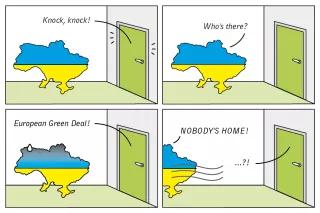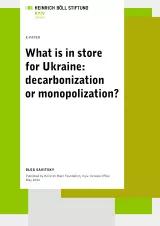
On September 22 high Representative of the EU for Foreign Affairs and Security Policy — Vice President of the European Commission Josep Borrell started his visit to Ukraine not from some welcoming ceremonies and handshaking with high-level officials, but with the meeting with anti-corruption activists. This is a strong message in itself. What does it tell us? Is it that COVID-19 made handshakes with Ukrainian officials prohibitive, or we are witnessing the onset of a new kind of morally dignified political hygiene?
“Ukraine has chosen the path of reforms and made a lot of progress. You can count on our support for the reforms, for the development of the anti-corruption infrastructure and the judicial reform. They are key to respond to the wishes of the Ukrainian people and to attract new investment” — later that day Borrell once more emphasized on anti-corruption support as a key focus of EU efforts at the joint press conference with the Minister of Foreign Affairs Dmytro Kuleba.
Indeed, bringing Ukraine on the pathway to sustainable socio-economic and ecologic restoration envisioned by the European Green Deal will require a lot of long-term strategic investments. Rule of law and anti-corruption enforcement is a key cornerstone to enable major green infrastructure investments. To make it happen a lot of things have to change.
Decarbonisation battlefield: oligarchy vs changemakers
This year Ukraine is experiencing a long sequence of corruption scandals, personal attacks on activists, attempts to replace management at strategic state-owned enterprises and strong rebound against market liberalization and environmental protection reforms. Since March, after abrupt reshuffling of the government, Ukraine is in fact, piece by piece, losing control over its economy and infrastructure to oligarchs and Russian proxies.
Such critical components of European Green Deal as energy efficiency, renewables and pollution control measures, which showed only the first sparks in Ukraine, are being practically extinguished by the actions of the new government and administration of president Zelensky. Funding of environmental protection programs in 2020 was transferred to cover non-transparent subsidies for coal mines. The ukrainian renewables sector which attracted record investments in 2019 is now in limbo with an official memorandum signed with government on support scheme restructuring, which is not effective due to constant manual re-arrangement of the monopolized electricity market. Long-nurtured poster child of Ukrainian reforms – the Energy Efficiency fund is being completely defunded in the draft 2021 state budget. The Ministry of energy seeks to postpone environmental compliance or closure of polluting coal plants for another 10 years. At the same time official Kyiv is declaring commitment to the European Green Deal and decarbonization.
Political turbulence is growing in Ukraine and there are clearly internal contradictions, but also clearly visible Russian interference in the energy sector. In this situation EU’s foreign policy now faces a critical challenge — will it manage to take a stand against lobbyists of incumbent dirty monopolies and aggressive Russian interests in Ukraine?
To navigate this emerging battlefield, it’s worth taking a deeper look on how the onslaught of oligarchy at the EU's eastern frontier endangers its historic effort to decarbonize European continent by 2050.
Decarbonisation dimension of EU-Ukraine relationships
Since 2011 Ukraine is a contracting party of Energy Community Treaty, EU’s key policy vehicle which serves the purpose of advancing EU’s policy principles and regulations beyond its borders. Established in 2006, the Energy Community Treaty was originally aimed at extending the EU internal energy market rules and principles to countries in the South-East Europe and Black Sea region on the basis of a legally binding framework. After the gradual expansion of the Energy Community acquis to include legislation on renewables, energy efficiency, pollution control and climate change, the Treaty has evolved into a policy vehicle for the acceleration of clean energy transition and overall decarbonization in South East Europe.
The obligation to align to the EU's climate policy was further strengthened in the Association Agreement, which Ukraine signed in September 2017. In particular, Ukraine is obliged to consult with the European Commission on the compatibility of new legislative proposals with the provisions of the EU acquis.
In 2018 this change and new emphasis on the need to integrate climate policy was officially reflected in the “Wachau Manifesto”, which was issued by the Energy Community Secretariat after the informal Ministerial Council, the joint meeting of ministers responsible for energy, environment and climate policy representing the contracting parties (Western Balkans, Moldova, Ukraine and Georgia), which took place at the Dürnstein castle in Wachau valley, Austria.
Back then the Energy Community established the process for contracting parties to set strategic 2030 targets in their integrated National Energy and Climate Plans (NECPs). Same as for EU member states NECPs in Energy Community contracting parties should set three major targets for 2030: increase the share of renewables in primary energy consumption, deliver energy savings with improved efficiency and achieve overall greenhouse gas emission reductions compared to baseline economic scenarios.
On 22 July 2020 technical assistance project “Low Carbon Ukraine”, which is funded by German government, submitted a draft of the NECP to the Ministry of Energy of Ukraine, the body responsible for the NECP preparation process. According to the Presidential Decree №837/2019, the integrated energy and climate plan has to be approved by the government by 30 September 2020, but this deadline is set to be missed as no public consultations were held on this draft document. This shows that open, inclusive and transparent policymaking faces major difficulties in Ukraine.
Also, as noted by Ivanna Klympush-Tsintsadze, Chair of the Committee for Ukraine’s Integration into the EU, at the parliamentary discussion held on 11 September, Ukraine has the problem of underutilized credit and financial capabilities targeted for support of energy sector reform and strengthening of environmental governance, including the receipt of even non-repayable funding and technical assistance from the European Union.
While European Union is playing a long game, dedicating efforts to deliver peace, prosperity, climate action and ecological restoration on the continent, governance in Ukraine remains vulnerable to corruption and is lacking long-term perspective. This not only undermines economic development of the country but also creates a source of instability, endangers proper maintenance of critical infrastructure (such as gas transit pipelines, gas storage facilities and nuclear power plants) and therefore poses risks for the whole continent.
It is also important to note that due to its long-lasting coal addiction and very poor energy efficiency performance Ukraine remains among the world’s biggest emitters of greenhouse gases (in 2017 Ukraine was 32th country by total emissions with 205,7 mln t CO2 equivalent) and is one of the most carbon-intensive economies in the world. GHG emissions per unit of GDP in Ukraine are two times higher than in Poland and more than three times higher than in Turkey.
Case study: derailed electricity market reform
In early spring 2020, after 4,5 GW of renewables added to Ukraine's power system in the previous 12 months, and due to reduced electricity demand caused by economic effects of COVID-19 lockdown, coal-fired thermal power generation capacity (which amounts to massive 17 GW) in Ukraine suddenly became stranded. On March 15, solar and wind electricity generation exceeded coal for the first time in Ukraine. On March 26 renewables output reached 3,4 GW, while coal power was reduced to 2,4 GW. Displacement of coal power plants from daily load particularly sharp due to seasonal increase of solar insolation.
That was really a major challenge for management of DTEK – Ukraine’s private vertically integrated coal and energy conglomerate, and its owner Rinat Akhmetov. Yet, they've found a way to meet this challenge.
In the course of abrupt reshuffling of the government suddenly initiated by president Volodymyr Zelensky, former DTEK employee Denys Shmyhal became prime minister of Ukraine. In 2018–2019, Shmyhal was in charge of the massive 2,3 GW Burshtyn thermal power plant – the cornerstone of DTEK's monopoly in the EU-synchronized western part of Ukrainian electricity grid, the main source of electricity export capacity to EU and associated with “carbon leakage”.
By the end of March, the new government led by Denys Shmyhal proposed a rearrangement of the electricity market. The proposal included changes to Public Service Obligation scheme with placement of additional burden of cross-subsidies on state-owned generation companies Energoatom and Ukrhydroenergo. Also forecast volumes of generation for Energoatom were curtailed in the reviewed 2020 electricity balance. Further steps included changes in market rules and political exploitation of the regulator - National energy and utilities regulatory commission (NEURC).
Actions undertaken by Shmygal’s government resulted in setbacks in electricity market reform and created a hostile environment for investments in the power sector. Now this government is seeking to set up a discussion with the European Commission on how to bypass EU’s environmental regulations on air pollution, extend the lifetime of depreciated coal power generation assets and strengthen DTEK’s electricity market monopoly domestically, while maintaining access to European markets for dirty electricity generated by Burstyn thermal power plant. Currently the primary recipient of this dirty electricity is Orban’s regime in Hungary.
In 2019 Burstyn power plant alone emitted more toxic pollutants than some European countries — 123 thousand tons of sulfur dioxide, 26 thousand tons of dust and 11 thousand tons of nitrogen oxides, while its fuel efficiency and specific CO2 emissions per kWh are 1,5 times higher than those of Polish or German coal power plants. Implementation proposed of Carbon Border Adjustment Mechanism (CBAM) if performed in a fair and effective way would lead to shutdown and decommissioning of this plant. Together with market liberalization and open access to cross-border transmission capacities this would also eliminate DTEK’s domestic monopoly and lower electricity prices for consumers in western Ukraine.
With synchronization of Ukraine’s transmission grid with ENTSO-E, which is scheduled for 2023 according to agreement signed by national transmission system operator Ukrenergo, major advances in decarbonization and demonopolization of power sector are achievable with supportive policy tools, such as CBAM, and can facilitate clean energy transition in the broader region.
Decarbonization roadmap as a solution for Ukraine: a bottom-up approach
Ukrainian civil society organizations emphasize the need for long-term and systematic planning of the energy sector, including nuclear safety issues, restructuring and continued public spending for energy efficiency, air pollution control and other environmental measures. But the key measure to enable decarbonization in Ukraine is a well-organized coal phase-out and the dismantling of the existing electricity market monopoly coupled with long-term localized approach to ensure just transition of coal regions.
Significant reduction of greenhouse gas emissions, transition to decentralized renewables, digitalization and introduction of new energy efficient technologies are possible and necessary in Ukraine. Implementation of these measures could be the key to a just economic recovery after the COVID-19 crisis. Ukrainian green NGO's argue that this year's budget review must not become the first taste of a new policy that ignores environmental protection and promotes extended coal use.
Civil society demands that the proper financing of environmental protection and energy efficiency measures should be restored in the 2021 budget. Priority should be given to comprehensive and just energy transition in an overall decarbonization framework in national policymaking.
Such a framework and justification for the ambitious nationally determined contribution of Ukraine to the Paris Agreement was developed in 2019 by civil society organizations and independent experts. They've come together to develop a 2030 roadmap for Ukraine to propose feasible decarbonization goals and sectoral strategies, that allow Ukraine to significantly reduce greenhouse gas emissions in all major economic sectors by 2030 and pave the way for complete decarbonization by 2050.
The 2030 Climate Goals Roadmap for Ukraine includes quantitative targets for five sectors: energy, buildings, transport, waste and one subdivide sector, which includes agriculture, forestry and land use. The goals have been developed based on an analysis of the legal framework, international examples and best practice, and the experience of public and leading experts, within these sectors.
Number of Ukrainian cities have already committed to clean energy and overall decarbonization and developed their local climate and energy plans. Zhytomyr was the first city to commit to go 100% renewable energy by 2050 and has already shown what is possible in the short term. The city has switched completely to LED-based street lighting, constructed a municipal solar power station and commissioned the first municipal building in Ukraine with zero emissions for an administrative services center. The local authorities of Lviv, Mykolaiv, Kamianets-Podilskyi, Chortkiv, Trostyanets and Baranivka have also set the goal to switch to 100% renewables by 2050 and already are working to advance energy transition locally.
Transparent and effective climate and energy governance in Ukraine requires inclusive discussions and active public participation, involving municipalities — those who will do a big part of the groundwork – and civil society organizations, who have long-term vision and expertise. This should be an integral part of preparation of national strategic documents, such as the draft National Energy and Climate Plan by 2030 which is currently in possession of the Ministry of energy.
Open public discussion and participation of local government representatives in decision making is an effective antidote to centralized political corruption and rule of oligarchy. Therefore, it is in the EU's best interest to ensure that inclusive and transparent national dialogue on 2030 targets takes place in Ukraine, enabling adoption of adequate and deliverable NECP.
By Oleg Savitskiy, climate and energy policy expert of Ukrainian Climate Network


